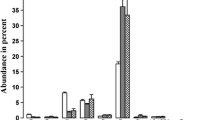Abstract
The cuticular chemicals of 124 individual wasps (foundresses and workers) from 23 colonies ofPolistes fuscatus were analyzed. The compounds identified, all of which were hydrocarbons, were similar to those of other vespid wasps in that the bulk of the hydrocarbons were 23–33 carbons in chain length. However, the hydrocarbon profile ofP. fuscatus differed from those of its congeners in its proportions of straight-chain alkanes, methylalkanes, and alkenes. Three of the 20 identified hydrocarbons, 13- and 15-MeC31, 11,15- and 13,17-diMeC31, and 13-, 15-, and 17-MeC33, had properties postulated for recognition pheromones: colony specificity, efficacy in assigning wasps to the appropriate colony, heritability, lack of differences between foundresses and workers, and distinctive stereochemistry.
Similar content being viewed by others
References
Blomquist, G.J., Nelson, D.R., andde Renobales, M. 1987. Chemistry, biochemistry, and physiology of insect cuticular lipids.Arch. Insect Biochem. Physiol. 6:227–265.
Bonavita-Cougourdan, A., Theraulaz, G., Bagnères, A.-G., Roux, M., Pratte, M., Provost, E., andClément, J.-L. 1991. Cuticular hydrocarbons, social organization and ovarian development in a polistine wasp:Polistes dominulus Christ.Christ. Comp. Biochem. Physiol. 100B:667–680.
Breed, M., andBennett, B. 1987. Kin recognition in primitively eusocial insects, pp. 243–286,in D.S.C. Fletcher and C.D. Michener (eds.). Kin Recognition in Animals. Wiley, New York.
Bura, E.A., andGamboa, G.J. 1994. Kin recognition by social wasps: asymmetric tolerance between aunts and nieces.Anim. Behav. 47:977–979.
Butts, D.P., Espelie, K.E., andHermann, H.R. 1991. Cuticular hydrocarbons of four species of social wasps in the subfamily Vespinae:Vespa crabro L.,Dolichovespula maculata (L.),Vespula squamosa (Drury), andVespula maculifrons (Buysson).Comp. Biochem. Physiol. 99B:87–91.
Butts, D.P., Camann, M.A., andEspelie, K.E. 1993. Discriminant analysis of cuticular hydrocarbons of the baldfaced hornet,Dolichovespula maculata (Hymenoptera: Vespidae).Sociobiology 21:193–201.
Dixon, W.J. 1981. BMDP Statistical Software. University of California Press, Los Angeles, 198 pp.
Espelie, K.E., andBernays, E.A. 1989. Diet-related differences in the cuticular lipids ofManduca sexta larvae.J. Chem. Ecol. 15:2003–2017.
Espelie, K.E., andHermann, H.R. 1990. Surface lipids of the social waspPolistes annularis (L.) and its nest and nest pedicel.J. Chem. Ecol. 16:1841–1852.
Espelie, K.E., Wenzel, J.W., andChang, G. 1990. Surface lipids of social waspPolistes metricus Say and its nest and nest pedicel and their relation to nestmate recognition.J. Chem. Ecol. 16:2229–2241.
Fletcher, D.J.C., andMichener, C.D. 1987. Kin Recognition in Animals. Wiley, New York, 465 pp.
Gamboa, G.J. 1988. Sister, aunt-niece, and cousin recognition by social wasps.Behav. Gen. 18:409–423.
Gamboa, G.J. 1994. Kin recognition in social wasps,in S. Turillazzi and M.J. West-Eberhard (eds.). Natural History and Evolution of paper wasps. Oxford University Press, Oxford.
Gamboa, G.J., Reeve, H.K., Ferguson, I.D., andWacker, T.L. 1986. Nestmate recognition in social wasps: The origin and acquisition of recognition odours.Anim. Behav. 34:685–695.
Gamboa, G.J., Klahn, J.E., Parman, A.O., andRyan, R.E. 1987. Discrimination between nestmate and non-nestmate kin by social wasps (Polistes fuscatus, Hymenoptera: Vespidae).Behav. Ecol. Sociobiol. 21:125–128.
Hepper, P.G. (ed.). 1991. Kin Recognition. Cambridge University Press, Cambridge, U.K., 457 pp.
Hölldobler, B., andMichener, C.D. 1980. Mechanisms of identification and discrimination in social Hymenoptera, pp. 35–58,in H. Markl (ed.). Evolution of Social Behavior: Hypotheses and Empirical Tests. Verlag Chemie, Weinheim.
Lorenzi, M.C. 1992. Epicuticular hydrocarbons ofPolistes biglumis bimaculatus (Hymenoptera Vespidae): preliminary results.Ethol. Ecol. Evol. 2:61–63.
Nelson, D.R. 1978. Long-chain methyl-branched hydrocarbons: Occurrence, biosynthesis and function.Adv. Insect Physiol. 13:1–33.
Pfennig, D.W., Gamboa, G.J., Reeve, H.K., Shellman-Reeve, J., andFerguson, I.D. 1983. The mechanism of nestmate discrimination in social wasps (Polistes, Hymenoptera: Vespidae).Behav. Ecol. Sociobiol. 13:299–305.
Rice, W.R. 1989. Analyzing tables of statistical tests.Evolution 43:223–225.
Singer, T.L., andEspelie, K.E. 1992. Social wasps use nest paper hydrocarbons for nestmate recognition.Anim. Behav. 44:63–68.
Singer, T.L., Camann, M.A., andEspelie, K.E. 1992. Discriminant analysis of cuticular hydrocarbons of social waspsPolistes exclamans Viereck and surface hydrocarbons of its nest paper and pedicel.J. Chem. Ecol. 18:785–797.
Smith, B.H., andMichener, C.D. 1987. Kin recognition in primitively eusocial insects, pp. 209–242,in D.J.C. Fletcher and C.D. Michener (eds.). Kin Recognition in Animals. Wiley, New York.
SPSSInc. SPSSx User's Guide, 2nd ed. SPSS Inc., Chicago, 988 pp.
Author information
Authors and Affiliations
Rights and permissions
About this article
Cite this article
Espelie, K.E., Gamboa, G.J., Grudzien, T.A. et al. Cuticular hydrocarbons of the paper wasp,Polistes fuscatus: A search for recognition pheromones. J Chem Ecol 20, 1677–1687 (1994). https://doi.org/10.1007/BF02059889
Received:
Accepted:
Issue Date:
DOI: https://doi.org/10.1007/BF02059889




